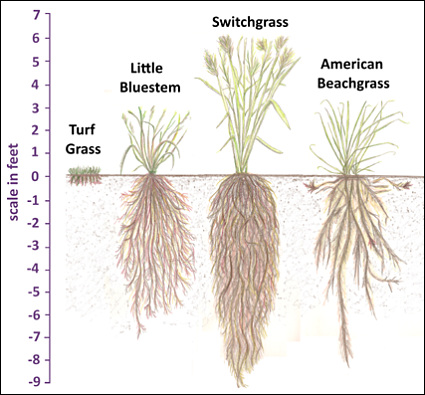Unless someone like you
cares a whole awful lot,
nothing is going to get better.
It’s not. ~ The Lorax
A Riparian Restoration
-
What is a Riparian Restoration?
Riparian areas are ecosystems that extend from both sides of a stream or river and serve as critical habitats for many plants and animals. Repairing efforts improve the diversity and dynamics of indigenous ecosystems degraded by human impacts. Restoration goals include reducing erosion, removing invasive species, and increasing species diversity.
-
Why Do We Care?
Frankly, our initial reason for approaching this project was to access and enjoy the lovely area we could partly see and partly imagine from the generations of barbed wire and severe brush overgrowth. However, as we continued our education and research, we learned that healthy riparian buffers can benefit wildlife populations’ food and habitat. Further, experiencing our first rainy season on the property highlighted some erosion concerns we could address by improving the native riparian grasses. Overgrowth choked out plant diversity that provided bank stability. Improving this riparian ecosystem would provide erosion control, healthy water downstream, improved soil, food and habitat for wildlife, and a beautiful place to enjoy a nature walk.
-

June 2022
Generational layers of barbed wire fencing allowed the overgrowth of yaupon and invasive non-native plants while inhibiting wildlife traffic.
-

July 2022
The primary human interaction was a dumping ground.
-

Summer 2022
Assessing the extent of trash collection and starting to remove what we could by hand.
-

October 21, 2022
When we realized how much trash there was, we ordered a 40 cubic yard dumpster. Ultimately, it was piled high and overfilled.
-

October 27, 2022
A grappler to extract the fencing, and…
-

October 28, 2022
….a mulcher to create a trail and reduce brush. Not only could we enjoy access, but we could also identify and mark invasives such as Chinese privet for management.
-

October 28, 2022
The trail
-

October 30, 2022
Among of the more interesting items collected plus a wringer washer.
-

November 2, 2022
These made the cut as souvenirs of our work.
-

November 11, 2022
Having taken out the barbed wire, we were welcomed by a small family of deer at sunrise.
-

November 13, 2022
-

December 11, 2022
Leftover fencing
-

December 29, 2022
An early native plant peeking through. These didn’t have room or light beneath the overgrowth but it was in the seedbank.
-

January 2023
Vegetation in a riparian area binds and holds the banks together and reduces the velocity of water, which would otherwise eat away at the banks and reduce soil nutrition. We are planting a native grass seed mix including blue grama, little bluestem, sideoats grama, and inland seaoats.
-

March 2023
Shrubbery tends to have shallow root systems compared to native grasses, which have root systems up to three yards deep. The deep grass roots enable efficient saturation and provide erosion control. It will take some time for them to fill in, so we re-purpose stones found on the property and fallen trees to slow run-off and erosion in hard rains.
-

Grassroots
Isn’t this fascinating? Not all grass is created equal. You can see why native grasses, whether riparian or prairie, play such a crucial role in erosion control and drought resistance.
-

April 6, 2023
-

April 7, 2023
Texas ragwort
-

May 26, 2023
At the onset of this project, there was little to be seen through the thicket of shrubbery and trash as there just wasn’t room or light available for anything else to thrive. This creekside display was an incredibly happy surprise after thinning the yaupon. The diversity is amazing!
-

June 4, 2023
They keep on coming….
-

June 11, 2023
…and coming.
-

August 12, 2023
Most dead trees are maintained as snags (home for native bees). However, we had a few trees that were decaying and dropping large limbs in areas that posed a danger. We had those removed and mulched.
-

August 18, 2023
The mulch is a terrific erosion control medium and lines our trails beautifully.
-

August 20, 2023
There was enough mulch to line almost all of the trails.
-

November 28, 2023
The beauty of native plants is that they change not just seasonally but annually. A walk along the creek is never the same. Blue mistflower, camphorweed, asters, and white avens, perhaps.
-

November 2023
The pink flowers and the deep purple berries are the two seasons of American beautyberry. Masses of fragrant tiny fragrant flowers show in May-August and provide ample nectar and pollen to bees, butterflies, and birds that eat attracted insects for their nesting babies. In the fall, the magenta-purple berries are food for over 40 bird species, and other wildlife such as armadillos, coyotes, foxes, possums, raccoons, and squirrels.
-

December 2023: Snag a Home
Restoration often means cleaning up. But keeping our snags is an important part of our riparian restoration. A snag is a dead tree that has been left to decompose upright. Not only have we come to see their unique beauty, but we leave all we can safely to serve as habitat. More than seven dozen species of North American birds use these trees for nesting and feeding. Many insects, including native bees, also use these dead trees for hibernation and laying their eggs in bored nurseries of the soft wood.
-

March 2024: Spring Forthm
Spring color is popping around the ranch! Two special March finds along the creek are Coralberry (Symphoricarpus orbiculatus) and Dogwoods.
-
CHECK BACK AND JOIN THE JOURNEY
Restorations never end, and we continue learning how to best protect our part of the planet. Please continue to follow our progress here and join us on Facebook for updates. We always welcome comments and questions!